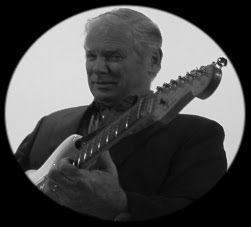New Book by Vic Flick
New Book by Vic Flick
released.
Book is
available now.
Book is available now.
Here are a couple extracts to whet your appetite:
John Barry had long used my guitar as the featured instrument in his Seven recordings and was now determined to milk the commerciality of the sound to the full.
Using the "plus four" sound and a full string section, we recorded "Stringbeat" in three sessions at EMI. In EMI Studio 2 to be exact. EMI 2 has been photographed many times so I expect most people know that it is a big room. Not as big as EMI 3, but still a big room. Along the back wall was set the rhythm section, piano, bass and drums. Slightly in front of them was a lone chair and music stand. That was where I sat and performed for 9 hours with just a few short breaks in between.
Faced with a wall of violins, violas and cellos I surveyed the pile of music in front of me. Turning page after page it dawned on me that I was never going to stop playing solo guitar for the whole day. Interspersed with the written notes were such comments as. "Fill behind strings" or "Adlib solo for 16 bars". I was starting to realize that quite a lot depended on me for the making of this album.
At that very moment, I didn"t realize how much my future session career depended on my performance during that day. All the contractors, or fixers, in the recording industry at that time were violin players. And all of them were sitting in a row a few feet in front of me!. Many of the string players, not knowing my capabilities, apart from those luckless violinist who had plucked their way to fame on the "plus four" recordings, met my eyes with stony looks as they assembled in front of me.
Guitarists today might listen to a copy of that album and find room for criticism. To my ears, the sound of my guitar left a lot to be desired by modern standards. Sometimes the playing was not as accurate as even I would have liked but I would challenge any one of them, under those circumstances and at that moment in time, to do better.
John Barry asked Les Reed and myself to each write a title. Les wrote 'Donnas Theme, and I wrote a piece called 'Zapata.' I was complimented many years later by Warren Bennett, the son of Shadows drummer, Brian Bennett, covering 'Zapata; and making a very good record.
I think it was twelve or thirteen titles I recorded that day for the album Stringbeat - all recorded onto compatible stereo. No tracking. No overdubbing. No, "I"ll put it on later." And all under the eagle eyes of some of the top string players in the world, let alone London.
The A&R man for those sessions was Norman Newell and his assistant was John Burgess. Both men went on to carve auspicious careers in the music business.
Arthur Greenslade was also the Musical Director for Engelbert Humperdink, a good singer who I have known for years and years, even before he was Engelbert.
Enge, as he likes to be called now, can, like many other singers, be very demanding. Because the arrangements were always good and on time, our Enge would ask Arthur to come up with a new arrangement, or an arrangement of a new song, sometimes as quickly as for the next day's afternoon rehearsal - and this request would come just before that night's performance.
Arthur's nerves couldn't stand this continual stress and he became seriously ill. Another factor that didn't help Arthur's condition was that previous to working with Enge, Arthur had been Musical Director to Shirley Bassey. Having worked with Miss Bassey on records, television and concerts, I can only wonder how there was anything left of Arthur to work for Humperdinck.
Anyway, Arthur had a complete nervous breakdown with the unpleasant side effect that his skin started to fall off. Being warned by his doctors that his body and his nervous system couldn't take any more, Arthur retired and went to live with his daughter in Australia.
He is now a happy man and plays piano when and where he wants to. Good on yer, cobber!
English Musical Director, Johnny Harris, who had taken up residence in the USA was the arranger, and the producer was a little guy who looked like he'd just come out of the jungle in Vietnam. Indeed, John wore the military paraphernalia any Navy Seal would be proud of, and that was just to conduct an orchestra. Completely immersed in the American studio jargon , John would regale us with quarters and measures instead of crotchets and bars.
Similar thing happened with Sammy Davies Jr.
With Johnny Harris again we were in the New Olympic and from the presence of the reporters and photographers we knew something was about to happen. Sure enough, in true American Star tradition, Sammy swept into the studio surrounded by a strong arm entourage who huddled round the podium with Johnny. After much discussion, show Biz type laughter and gesticulations, the huddle crabbed its way to the singer's booth for the recording to start.
As usual we never knew what was going on but I think the song was for a film. The song was good, the band was great and Sammy was wonderful - full of energy and talent. Once the take was OK'd, the huddle gathered itself and funneled its way out the studio door never to be seen again. I tell friends I've worked with Sammy Davies Jr. and they ask, ' did you talk with him?' Talk with him? I was lucky to see the top of his head!





Comments
Post a Comment